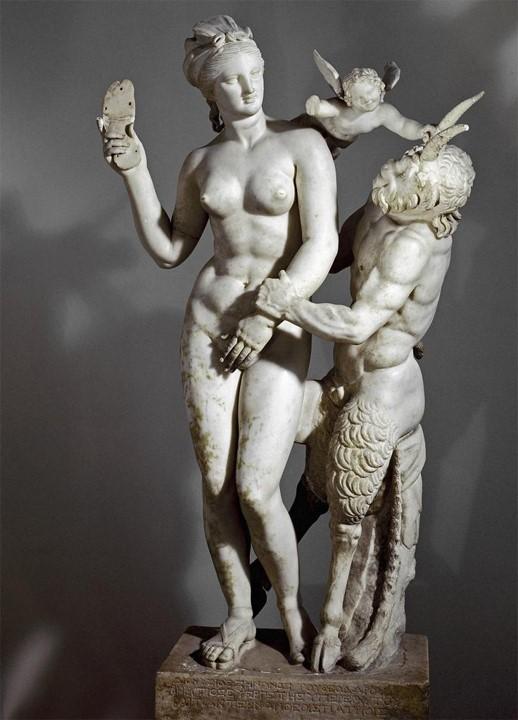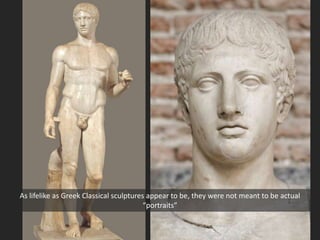For Hegel Romantic Christian art was the high point of the history of art a history which he believed complete and closed. Art imitated the art of greeks but used a more naturalistic approach.
The tendency to the most complete and absolutely accurate reflection of reality in all its manifestations details and details.

. During the classical period Greek sculptures did what no one had done before by worshiping the human body through bronze and The sculptures were both human-size and human-like. In Annibale Carraccis Flight into Egypt 1604 the figures have been totally overwhelmed by a landscape which though containing much naturalistic detail is a highly ordered and tidied-up vision of nature. Classical Greek sculptors were more imaginative because the Enlightenment released them from the dogma of the pharoahs.
These relief sculptures are known for their dynamic movement and realism and decorated the temple chambers interior walls. Greek sculpture marked the height of Classical art and Romantic art grew with Christianity. The Greeks and Romans both represented gods and rulers in the form of statues a combination of religious and political influence.
In the fallen warrior greece and the dying gaul roman copy both clearly represent a. Classical greek sculptures became increasingly naturalistic and began to show the body as alive and capable of movement while maintaining an interest in portraying the ideal human anatomy Greek Architecture. Ink color and gold on silk 1153 x 493cm Mary Griggs Burke collection Naturalism and realism.
The Classical period saw changes in both the style and function of sculpture. The sculpture of the ancient Greeks had a major impact on. Classical Greek figures appear more relaxed than the rigid formal Egyptian and early Greek sculptural poses because _____.
Symbolic art for example was found in ancient Egypt. The Hellenistic art form is seen to be depicting more emotions. Defined by a careful observation of nature a new concern for the mechanics of the body and the pursuit of ideal forms Classical Greek sculpture represents a radical departure from the compact forms and upright poses of Archaic male nudes.
The sculptures were generally polychrome except for works made in bronze. In this sense the work lacks realism since in a way according to ancient Greek views it is too perfect. The sculpture of the Italian Renaissance comprises the approximate period between the late fourteenth and the early sixteenth century when Italian sculpture expressed a reaction against the aesthetic principles of Gothic and assimilating the influence of classical antiquity art humanism and rationalism developed a style that merged naturalistic and other idealistic elements into.
This sculpture and other reliefs of this time have influenced later artists like Auguste Rodin. A similar conflation can be found in the medium of classical sculpture which is both naturalistic and idealistic. Poses seemed more naturalistic as shown by the Polykleitos of Diadumenos sculpture.
This tendency characterizes the change from High Classical to Late Classical Greek art. The only materials available to the Egyptian sculptors were stones that had a very. The classic sculptures do not come with these emotions but were idealized or static.
In Hegels analysis each style of art also had its paradigmatic art form. The Parthenon Marbles created by Phidias are perhaps the most famous examples of this style of Classical Greek sculpture. Satsubari The Second of the Sixteen Rakan late 14th century hanging scroll.
The classical period characterized modifications in both the function and the style of the sculpture. From about 500 BC statues began to depict real people. Classical Greek sculpture is both naturalistic and idealistic.
The scientific skill of Greek sculptors in showing the human form in distinct poses was improved. The origin of sculpture in Greek and Roman art can almost be divided into distinct categories- classical and idealistic vs naturalistic and emotional sculpture work. Classical Greek sculpture is both naturalistic and idealistic.
Absolutely both in terms of composition and also of applique. Look up Painted Greek Sculpture just to start and know that then as now every surface has a finish. Poses became more naturalistic see the Charioteer of Delphi for an example of the transition to more naturalistic sculpture and the technical skill of Greek sculptors in depicting the human form in a variety of poses greatly increased.
Whether deliberately applied. The Greeks idealized the human form because much of their art was a. Classical sculpture was both naturalistic and idealistic Government assembly halls The first Christian churches were patterned after basilicas used by he Romans as.
Roman artists typically made realistic portraits and sculptures. It is therefore highly idealized. Access the answers to hundreds of Ancient Greek art questions that are explained in a way thats easy for you to understand.
One of the most important categories of art developed by the classical painters of the 17th century was landscape painting. The naturalism also idealism in art is a flow of about 1870 to 1890 in the broadest sense. 3 points QUESTION 25 1.
Indeed John Boardman describes the work of Polyclitus Fig 2 a sculptor who canonized the male athletic body in classical period art as ideally realistic Boardman 157. Classical Roman art differed from classical Greek art because Roman art focused on realism while Greek art focused on idealism. Portraying the dramatic features that are filled with happiness anger agony and humor.
In the visual arts such a tendency manifests itself constantly from time to time taking shape in. Yet both statues feature idealized human beauty and both use contrapposto counterbalanced poses. The classical art form originated well ahead of the Hellenistic period.

Form And Reality The Classical Greek Balance Of The Ideal And The Natural Disrecognized Space

Art History Midterm Flashcards Chegg Com

Classical Greek Sculpture Is Both Naturalistic And Idealistic True Or False Study Com

On The Literature And Thought Of The German Classical Era 11 Laocoon In Germany Open Book Publishers




0 comments
Post a Comment